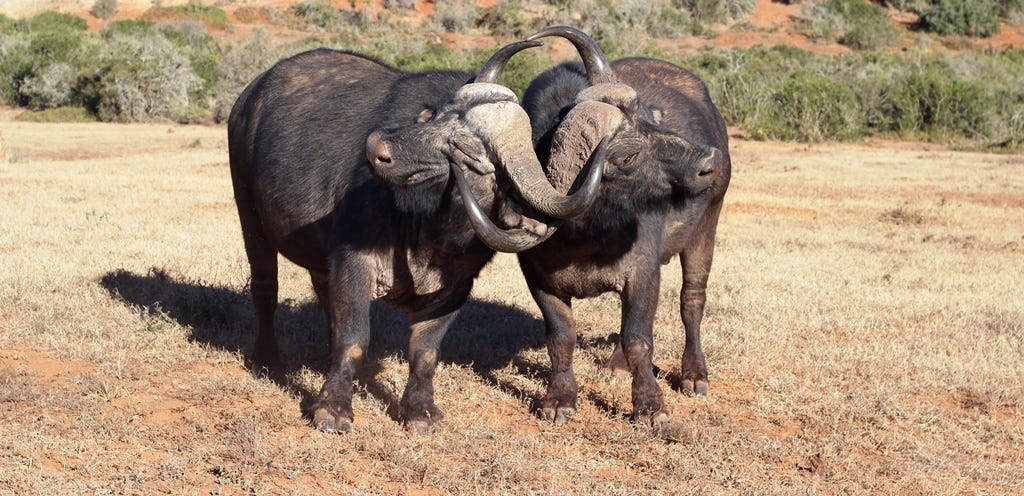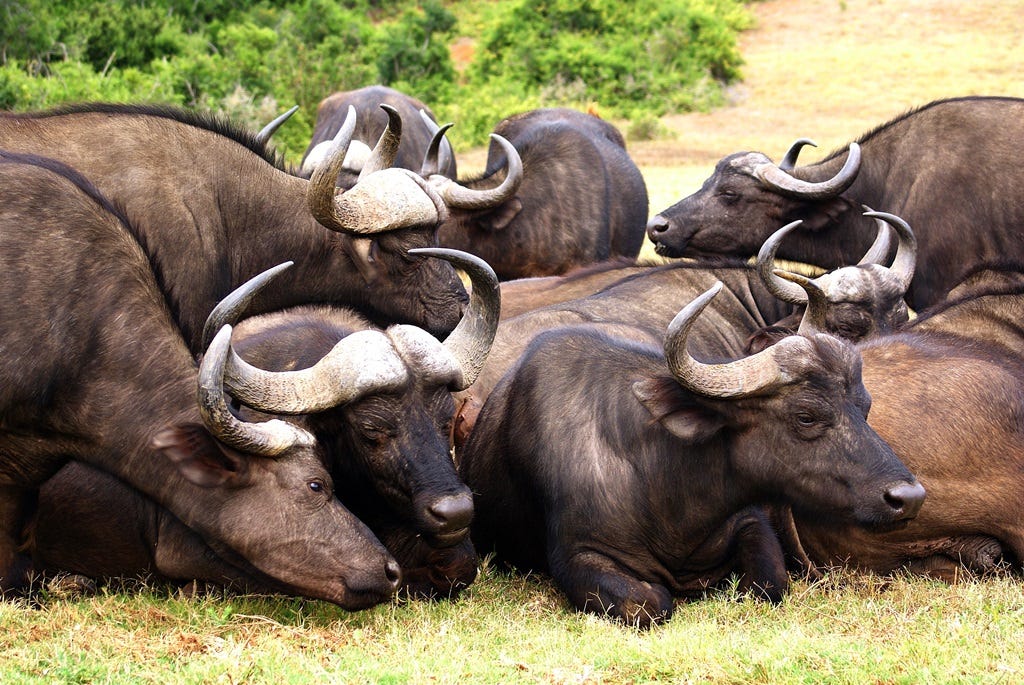The Cape buffalo is a card-carrying member of the ‘Big Five’. You’ve seen one . . . so tick it off your list. What else do we have to see to complete our sightings of the ‘Big Five’?
The Syncerus caffer, to give the buffalo its scientific name, is big – weighing up to 900kgs (about one ton). Dark brown or black fur cover its powerful, well-muscled frame making it unusually handsome when the light is just so.
It is reasonably calm most of the time, but can be extraordinarily dangerous when provoked. They look a lot like black cows, so we might mistakenly presume that like most cows, they are placid and approachable. If you believe that, you could be making the worst assumption of what’s left of your life. Do not meddle with buffalo. Ever.
Many expert hunters regard buffalo, especially the wounded ones, as the most dangerous animals in the bush. If ever you go on safari with a field guide, you can expect to pass the evening around a large bonfire listening to tales about inexperienced hunters who have followed the blood trail of a wounded buffalo. The enraged animal runs away at first but then circles back to charge the hunter at short range – often with messy consequences.
If you plan on a game drive in the Addo Elephant Park (AEP) you can expect to see some buffalo. They are common in most parts of the park and don’t rush away if you drive up close to them as they graze on the side of the road or if they happen to be crossing as you drive around a curve. They move away but not so fast.

The most common type of buffalo sighting is that of a single animal, or maybe a small group of three or four old bulls known as ‘dagga boys’. The origin of the term is not clear. I found various references online and there seems to be some consensus about ‘dagga’ being the word for mud in an African language. Since old bulls love to cover themselves in mud, the name stuck – well, sort of like mud.
Dagga boys are old bulls who have passed their prime and been expelled from the herd. They might have been dethroned by younger, fitter males but they are still frighteningly strong and rather grumpy about their state of exile. They are not to be trifled with.
Often they are seen alone, but it is not unusual to observe them in loose groups of up to five animals where they tolerate each other for mutual protection.
Breeding populations of buffalo, including bulls, cows and calves move around in large herds.
When lion meets buffalo
Online you can see many videos of encounters between lions and buffalo. They are often heart-rending, protracted battles to the death. Sometimes the lions make a long cruel kill, but other times they don’t and instead individuals suffer gaping wounds where horns have pierced their skin.

Personally, I have seen a buffalo chase a lioness at Peasland waterhole in the AEP. I have also witnessed four dagga boys charging down the hill to scare away a lioness who thought she owned the Ngulube waterhole.
One of the most spectacular sightings I have ever seen was a confrontation between a pregnant lioness and a dagga boy in the Kruger National Park. I was on a bus full of journalists from about half-a-dozen countries. The bus stopped on a bridge over a shallow river as the driver noticed a buffalo lying down on one of the banks.
He was resting and appeared to be contentedly chewing the cud. Essentially, he was minding his own business.
A heavily pregnant lioness slunk out from the tree-line and immediately adopted a stalking posture. She appeared to be alone and I guessed that she had already left her pride in preparation for giving birth.
Her movements were slow and stealthy, but you could not say it was a ‘leopard-crawl’ - it was more like a sort of ‘leopard-waddle’. Her ungainly but cautious creeping brought her ever closer to the bull who was clearly not aware of her silent approach. He was facing the river with his back to the lioness.
I am quite certain that even if she had crept right up to his hind-quarters and jumped onto his back she would not have been able to subdue the bull. The odds of a single lioness against a lone buffalo are not good under normal circumstances, but when she is on the verge of giving birth, it seems like a suicide mission.
I believe that her taking up a hunting position while disregarding her condition was pure instinct. This is what a lion does when a buffalo is lying down not ten metres away. There was never any realistic chance of her taking the old bull down – unless of course she had sisters hiding in the bushes nearby.
It was not to be. She had crept up so close that she had to take the next step in the plan. She paused for a few seconds and then suddenly he must have got wind of her. He jumped up as quickly as an old bull can and spun around to face his would-be predator.
She was busted and visibly weighed down.
I expected nothing less than the bull charging at the lioness without a moment’s hesitation. This is exactly what happened. He chased her towards the bridge where our bus had parked. She ran right up to the bridge and stopped when buffalo’s charge had run out of enthusiasm.
She looked up at the occupants of the bus and scowled sheepishly as if to challenge us to do better.
Unique buffalo of the Addo Elephant Park
The buffalo herd in the AEP is disease free which means they do not have bovine tuberculosis, foot-and-mouth disease nor corridor disease. This makes them unusual and particularly valuable.
In South Africa there are strict laws governing the translocation of buffalo. It is illegal to transport them from one reserve to another unless the owners can prove that they are disease free. The danger is that some of these diseases are transmissible not only to other buffalo, but also to other bovines, lions or hyenas.
The herd at Addo is disease free because there were only about 30 isolated animals left when the park was established in 1931.
Buffalo are naturally diurnal and usually move around in big herds except of course for the grumpy old dagga boys. However, when wholesale hunting in the 18th and 19th centuries decimated the Eastern Cape herds, surviving buffalo found it prudent to move about at night. Hunters used to go on killing sprees by day when buffalo found it safer to hide in thick bushveld and go grazing at night.
The Addo herd remained largely nocturnal until park management reintroduced lions in 2003. Lions enjoy the advantage of much better night vision than their prey animals so the buffalo reverted to their version of diurnal normality.

Fortunes of lions and buffalo are closely linked in many reserves across Africa, including the AEP. Buffalo are dangerous prey animals but they also seem to be a lion connoisseur’s favourite. Furthermore, they are big so they provide plenty of meat for a large pride that can last for a few days.
The six lions introduced into the AEP in 2003 grew to about 13 in 2019 and soon it was noted that these lions were taking out a lot of valuable (disease free) buffalo. The number of lions was brought down by transferring some of them to other reserves.
At the moment there are only five lions in the main section of the AEP and they appear to prey on a variety of species. They hunt buffalo, but they also go after zebras, kudus and warthogs. The pride matriarch, affectionately known by Addo Addicts as Josie, cannot be very helpful in hunting buffalo because she is blind in one eye.
Reducing the population of lions has meant that the buffalo herds are doing rather well and especially the younger generation of very cute calves is thriving. You are now more likely to see buffalo in the AEP while lions have been a little scarce.
If you have enjoyed reading this edition of the Real Safari Newsletter, please encourage your friends to subscribe too, and if you have any comments please share them below.







Thanks Steven for fantastic Buffalo read! Chuckling away.'making dagga' is the mixing of cement, sand and water.
Wonderful newsletter !